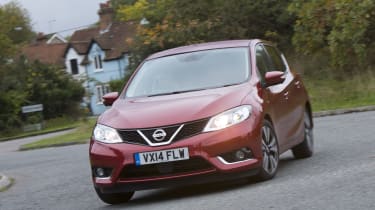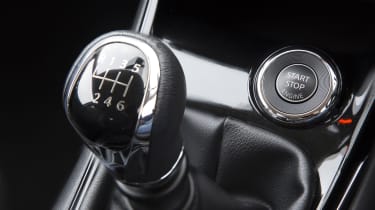Nissan Pulsar 2014-2018 review - Engines, performance and drive
Downsized engine range offers great economy and emissions, but performance is not on the menu
Nissan admits that when developing the Pulsar, it didn’t aim for the fun factor of the Mazda 3 or Ford Focus, Instead, it targeted the refinement of the VW Golf and Audi A3. In most respects, it has succeeded. Apart from a flutter of wind noise from the large door mirrors above 65mph, the Pulsar is very quiet at a cruise, especially with the 113bhp petrol engine instead of the slightly noisier 109bhp diesel.
Point the Nissan down a twisting back road, and you’ll discover strong grip and direct steering. There’s no feedback through the wheel, though, and the car suffers from some distinct body roll. Torque vectoring helps to resist understeer, while the progressive brakes and precise gearshift are easy to use.
Although the Pulsar is far from entertaining to drive, its refinement and space mean it deserves more credit among its talented rivals than the long-forgotten Almera ever mustered.
If taking it easy, wind and road noise are well suppressed, but while the combination of soft suspension and 16-inch wheels soaks up big potholes and bumps, the Pulsar feels unsettled on rough surfaces. Still, the driving position provides good visibility.
The faster 1.6-litre turbocharged model arrived in 2015, but even the extra power and chassis tweaks haven’t turned the Pulsar into a truly entertaining car. Instead, decent ride quality and light controls remain the order of the day here.
Engines
The engines are mostly well-mannered, though overly tall gearing forces them to labour harder than they otherwise might when accelerating, which blunts performance. No engine feels as sprightly as we’d hope, denting the car’s fun factor.
The entry-level 1.2-litre petrol engine makes the 0-60mph dash in a relatively leisurely 10.7 seconds and is flat-out at 118mph. The bigger 1.5-litre diesel shares the same top speed but takes almost a second longer to go from 0-60mph. It’s worth noting that if you choose the diesel for its good economy over long distances, you’ll save on fuel but lose a noticeable bit of refinement.
The 1.6-litre turbo petrol option brings the 0-62mph time down to a quite respectable 7.7 seconds, and raises top-speed to 135mph.





